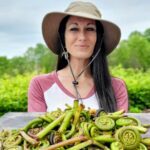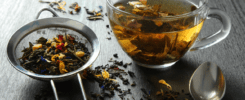The Efficient Remedy
What is a tincture ?
Tinctures are concentrated herbal extracts made by soaking specific plants in alcohol for a few weeks.
Tinctures date back as far as distilled alcohol. Ancient Egyptians soaked herbs in alcohol to create tinctures and cordials- tinctures made with lower alcohol content. In 1025, The Al-Qanoon fi al Tibb (The Canon of Medicine) was published, explaining many medical topics including herbal tinctures. It was the basis for the teaching of medicine in the West from the 12th-17th centuries, making the discoveries and uses of distilled alcohol ingrained in Western medicine.
Today, tinctures have become the most popular form of herbal medicine used by herbalist, as they are efficient, effective, and easy to make.

Why do we take Tinctures & Extracts?
Tinctures are dietary herbal supplements in a concentrated, shelf-stable, liquid form. Like other herbal extracts, tinctures can be used to support a wide range of wellness goals. Their effects will depend upon the herb or herbs tinctured, the amount and frequency taken, and the individual ingesting them, so it’s recommended that folks consult a qualified medical professional for advice on appropriate use for your personal needs. Tinctures can be taken straight by the dropper or diluted in tea, juice, sparkling water or any preferred beverage.
Solvents Used
When making a tincture you need a liquid to act as your extractor.
All tinctures are extracts, but not all extracts are tinctures! Alcohol must be the solvent used to extract the herbal properties. If you are using vinegar, glycerine, or any solvent other than alcohol, your preparation is an extract, but it is not a tincture.
Alcohol: Any spirit may be used, but many herbalists prefer something neutral like vodka so the taste of the herb comes through.
40% to 50% alcohol by volume (80- to 90-proof vodka) “Standard” percentage range for tinctures. Good for most dried herbs and fresh herbs that are not super juicy. Good for extraction of water-soluble properties.
80-proof vodka and half 190-proof grain alcohol) Extracts the most volatile aromatic properties. Good for fresh, high-moisture herbs like lemon balm, berries, and aromatic roots. The higher alcohol percentage will draw out more of the plant juices. This volume works well when making homemade vanilla extract.
85% to 95% alcohol by volume (190-proof grain alcohol) Good for dissolving gums and resins but not necessary for most plant material. Extracts the aromatics and essential oils bound in a plant that don’t dissipate easily. This alcohol strength can produce a tincture that’s not easy to take and will also dehydrate the herbs if used for botanicals beyond gums and resins.
Vinegar: Vinegar is used for people that are alcohol sensitive such as children. It can be used in the same way as the alcohol when making a tincture. The difference between using vinegar and alcohol is going to be the concentration level. Alcohol is a more robust extractor and is better at getting the medicinal properties out of tough woody parts of plants. It also has a far longer shelf life than vinegar. Extracts made with vinegar however are still effective and efficient, and make a great solvent choice when making remedies for children. If you choose vinegar as your solvent, make sure you purchase vinegar with the mother. This will contain all the beneficial enzymes to make your remedy a little more medicinal.
Glycerin: Glycerin extracts are similar to vinegar extracts in concentration levels with an added sweet taste. This makes it the preferred solvent choice by large corporations whom produce children’s extracts. Glycerine extracts are also made different than a typical tincture. Instead of filling your jar with vodka or vinegar, you will measure out 3 parts of glycerin, per one part filtered spring water. I personally don’t recommend using the glycerine method unless you are using organic glycerin. Glycerin is clear liquid typically made from soybean. Not only is soy one of the top GMO crops in the world, it is a powerful (phytoestrogen) endocrine disruptor. Studies are starting to scientifically prove the detrimental effects GMO’s and soy have on human health, therfore, it best to avoid glycerin unless organic.

Folk Method
The traditional folk method is the best way to go when making a tincture or extract. This age old method is simple, practical, efficient, and doesn’t require any special tools. It does however require patience.
Supplies
• Organic herbs (roots, leaves, flowers)
• Glass jars (Mason jars work well)
• Organic Solvent (Alcohol, Vinegar, Glycerine)
• Cheesecloth and strainer
• Amber bottles
Instructions
Your first step is to fill your container with the correct amount of herbs. Proportions are important here: too little, and you’ll end up with a weak tincture. Too much, and the amount of alcohol added won’t be enough to pull out all the medicinal properties from your herbs.
The appropriate alcohol strength and the relative amount of plant material to use will vary based on what you’re tincturing.
Here are some basic measurement guidelines:
Fresh Leaves and Flowers : Finely chop herbs to release juice and expose surface area. Only fill jar 2/3 to 3/4 with herb.
Dried Leaves and Flowers: Use finely cut herbal material. Only fill jar 1/2 to 3/4 with herb.
Fresh Roots, Bark & Berries: Chop or grind clean plants to release juice and expose surface area. Only fill jar 1/3 to 1/2 with fresh roots, barks, or berries.
Dried Roots, Barks, & Berries: Use finely cut herbal material. Only fill jar 1/4 to 1/3 with dried roots, barks, or berries. Remember, roots and berries will double in size when reconstituted!
Once filled, the jar will look somewhat full, but the herbs inside should move freely in the liquid.
Combinations
So if we follow these rules, how do we make combination tinctures? Good question!
Making combination tinctures is not as hard as it seems, and most herbs blend well together as long as you keep the amount in the jar below half. You are usually not combining plants and resins togather, therefore 80 proof vodka is fine for most herbs.
Another way, is to combine already made tinctures. A great example would be one part burdock root tincture and one part dandelion greens tincture. They would both be combined in the same bottle, but infused separately.

Infusing
Once you have placed the correct amout of herbs in the jar, fill to the top with your alcohol (or vinegar). Place a piece of parchment paper on top of your jar before placing your lid. This will help prevent any corrosion.
Shake your jar well and sit on a counter. Shake daily, or every other day for 4-6 weeks.
A typical tincture is usually left to infuse no less than four weeks, but six weeks seems to be the preferred duration. Some herbalist however choose to infuse their tinctures for up to 6 months. It is believed that the longer soak times help extract a full spectrum of plant compounds.

Storage
After your tincture is finished infusing, you will strain the herbs out using a cheese cloth placed inside of a strainer. This filtered liquid is your remedy!
Store liquid in amber bottles in a cool dark cabinet.
Shelf life: Your tincture, if made with alcohol, will last as long as the alcohol does. If made with vinegar, about one year.
Label
It is extremely important to label and date your tincture. The label should contain a list of all the herbs used and date it was finished and bottled.
The last thing you want is a bunch of tinctures and you can’t remember what they are! Trust me you won’t, we’ve all done it ha!
Recommend Doses
For acute health problems: 1/2 -1 teaspoon every few hours up to 6 teaspoons daily
For chronic health problems, prevention or maintenance: 1 teaspoon, 2 to 3 times daily, up to 3 teaspoons daily
Children Recommend Dosage:
• 10-30 lbs use 10-20 drops, 2-3 times daily
• 31-60 lbs use 20-40 drops, 2-3 times daily
• 61-100 lbs use 40-60 drops, 2-3 times daily
Cautions
Herbal medicine is still medicine. It’s important to understand the safety precautions of all the herbs that you intend to use. Certain herbs can have interactions with medications as well as health disorders. Speak with your health care provider first if you have any health concerns, pregnant, nursing or are taking medication. This applies to anybody you are making a remedy for as well.
Certain herbs are also not safe for children. Make sure you have knowledge of the herbs your using and their function before you administer to children. Remember, always do your own research because you are using these at your own risk. View our disclaimer here.

Final thought
There are many herb combinations that can be used when making a tincture. Many herbs pair well together. You can use tinctures for colds and flu, insomnia, anxiety, allergies, arthritis, high blood pressure, and so on. You can also use tinctures as a prevention measure for health disorders such cancer. Everything depends on your own personal preference and what meet’s your family’s needs.
Humans are made of an organic state, the same as the rocks, plants and animals. When we keep our bodies aligned with nature, we live healthier more fulfilling lives.
Stay Wild

